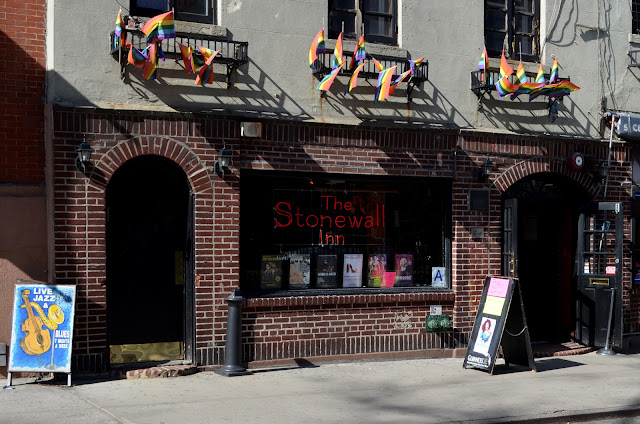We begin at 56 7th Ave S, with one of the few advertisements for a business you'll ever find on this site: Greenwich Locksmiths, and their wonderfully wild facade.
Opening in 1968, the building stayed much the same, until in 2008 when owner, Phil Mortillaro, had the idea to cover the front - using 50,000+ keys - to portray his version of Starry Night by Vincent Van Gogh. It took him until 2010 to complete the work.
Walk a little south, and then make a right to go up Bedford Street for some post-Colonial American history.
On the corner of Commerce Street and Bedford is 77 Bedford, which is the oldest house in the area.
Built by copper magnates, and known as the Isaacs-Hendricks House, it was constructed in 1799, using wood, but later converted to brick in 1836.
Next door to it, at 75½ Bedford is the thinnest house in all of New York City, with an exterior width of 9 feet (2.7 meters), and an interior of 8 ft (2.4m). Built in 1873 as a cobbler's shop, the small plot of land was then converted into a candy factory in 1880, when candy heiress Martha Banta bought the property. It later passed from owner to owner, but its size made it an interesting entry into the New York Historical Society newsletter, complete with a photo, in 1922.
Sadly, I couldn't take a decent picture of either (except for the door at 75½), due to both being under construction.
As you walk north on Bedford Street, always look up at the corners of buildings. There, one can usually spot markers with a bit of history about the area.
Still on Bedford, one will soon approach 17 Grove Street, in which stands the oldest wood home in Manhattan.
Constructed in 1822, the building was two-stories tall, until 1870, when a third floor was added. The house was originally owned by sash-maker William F. Hyde, but the public can take a look inside every year, when the Greenwich Village Historical Society does its annual "house tour".
Keep walking north, and then make a left, onto Christopher Street, to check out Weehawken Street: Manhattan's shortest block.
The street used to have an amazing set of "no urinating" signs, that were often photographed by visitors, but have since been removed. You can see a classic one online here.
Now, walk two blocks north, and back east a bit, to 121 Charles Street, where an anomaly stands.
No one is certain when it was first built, though tax records do show the home appearing on maps in 1898. What makes this so strange is that the farmhouse, which sits on this small triangular-shaped lot, wasn't even here until 1967.
The building originally stood at 71st Street, and York Avenue, and, in the 1940s, was owned by author of Good Night Moon, Margaret Wise Brown.
In the 60s, the Roman Catholic Archdiocese of New York bought the land, and the house was scheduled to be demolished, so as to build an old-age home.
On March 5th, 1967, with the help of architect William C. Shopsin, and at a cost of $6500, Swedish-born Sven Bernhard, who lived at there at the time, had the structure - in its entirety - moved to where it is today.
Now, the last spot visited on this roundabout isn't weird, so much as it is historically significant, and quite interesting.
On June 28, 1969, the patrons of the Stonewall Inn, were tired of the police harassment, and constant arrests, simply for their sexuality, and rioted against their mistreatment.
This one act opened the door for, what was then called, the Gay Liberation Movement in the United States. The Stonewall Inn was originally opened in 1967 (at 51-53 Christopher Street), and was then the largest gay establishment in the U.S. Closed soon after the riots, the spot reopened as a shoe store, a bagel shop, and later a Chinese restaurant. In 1990, the bar reestablished itself (at 53 Christopher), and was entered as a National Historic Landmark in 2000.













